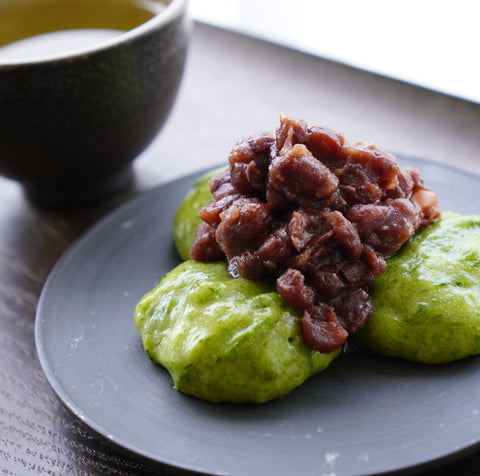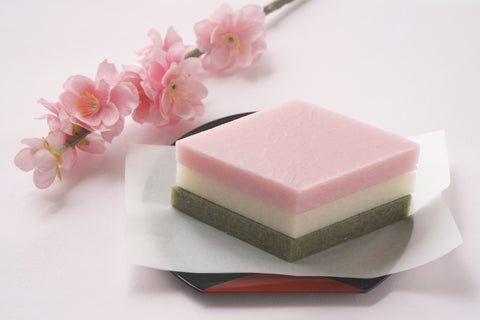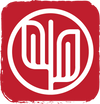よもぎって何ですか?
この植物は日本では3月から4月にかけて生育するのを見ることができます。

ヨモギといいます。
ヨモギ(学名:Artemisia Princeps、キク科)は、ヨーロッパに生息するヨモギ(学名:Artemisia vulgaris)の近縁種です。多年草で、北海道を除く日本各地の山地、丘陵地、さらには都市部にも自生しています。
伝統的に、それは食べ物として食べられ、さまざまな健康状態の治療薬として摂取され、また悪霊から身を守ると信じられてきました。
歴史を食として
日本人は春に山菜として若葉を摘み、煮て和えたり、天ぷらにして食べます。独特の青々しい香りとほろ苦さが、春の訪れを感じさせてくれます。
 よもぎの葉の天ぷら
よもぎの葉の天ぷら
最近では餅や団子などの伝統的な菓子に入れて食べるのが人気です。

よもぎ餅
よもぎ餅作りは、春の私のお気に入りのアクティビティの一つです。作り方にご興味のある方は、こちらの記事をご覧ください。よもぎ(日本のヨモギ)、よもぎ餅の作り方
よもぎ餅は春のお祝い事に使われます。こちらは3月3日の桃の節句に食べる菱餅です。

これは5月5日の子供の日に食べられる柏餅です。

よもぎは春のお祝いや子供や人々を邪悪な霊から守るために使われてきたと考えられています。
漢方薬としての歴史
ヨモギは長い歴史の中で万能の生薬として扱われてきました。850年から858年にかけて書かれた書物に初めて薬草として記載され、以来人々の生活に欠かせない存在でした。化学薬品が開発され普及するまでは、止血作用、抗菌作用、かゆみ止め、虫刺され防止などの効能があるとされてきました。
よもぎは口内炎にも効くと言われています。先日、口の中に2つもできたので試してみました!その日は5~7食後、毎回よもぎ湯でうがいをしました。すると翌朝には口内炎が消えていました!本当に効きました!実証済みです!
デトックス、消化不良、胃酸過多、血行不良、リラックス、ホルモンバランスなど、様々なお悩みにヨモギが効きます。すごい!ヨモギが「万能の生薬」と呼ばれる理由が分かりますね。まさにその通りです!

近年、よもぎは特に女性の間で再び注目を集めています。お茶、粉末、エキスオイル、化粧水、クリームなど、様々な製品が開発され、飲用、料理、入浴、スキンケア、リラックスなど、様々な用途で愛用されています。
人々が自然と共に生きることについてもっと考え始めたようで、今後数年間でヨモギはさらに人気が出るかもしれません。地元のヨモギを調べて検索し、どのように楽しむかを調べてみるのも面白いかもしれません。
関連記事
本日のおすすめ
・青森産よもぎパウダー 京の乾物屋 京の乾物屋 青森産よもぎ使用よもぎ粉
青森産よもぎを乾燥させた粉末です。パンケーキ、クッキー、ケーキなどに混ぜてお召し上がりください。また、カップにお湯を注いでお茶としてお召し上がりください。

よもぎ茶など沖縄産ハーブブレンドティー
原材料:ウコン(ウコン)、ハトムギ(ハトムギ)、リュウキュウヨモギ(Artemisia princeps)、柿の葉、サルノコシカケ(ドクダミ)、ヒマラヤクコの葉、シナノキ(種子)、ミカン(日本ミカン)の皮、アマグサ(中国カンゾウ)、シナモン



4件のコメント
Thank you for sharing an interesting story! I’ve also done it to make me warm, and improve digesting.
My grandmother used it as radiation treatment. She’d dry it out and mash it. Then formed tiny pea sized balls out of them. When my mom had terrible stomach pains and digestive problems as a child, grandmother would put 4 of these little balls around my mom’s naval equidistant from each other and a finger joints distance from her naval. Then she would make them glow with fire. After feeling the heat for a little bit, the little balls were taken off. Mom, now 90, still has the scars. But, she never had the stomach problems again. Maybe she was scared to be burned again?😆
Thank you for your comment. I usually put some yomogi in boiling water and boil for 1-2 minutes, and I drink the hot one without any sweetener. I think this is the typical way that people used to do. But I also sometimes enjoy it with soy milk, sometimes with honey, too.
Is it typically prepared in a certain way as a drink? Hot or cold? Sweetened or unsweetened? Sugar or honey? Etc.
To me, personally, the bitterness is refreshing so long as it’s not brewed for too long (I wouldn’t brew it more than 2 minutes or so). It seems like it would be tasty either hot or cold. I’ve liked it with honey rather than sugar. But, I’m curious as to how it’s prepared in Japan (if there is a particular way).